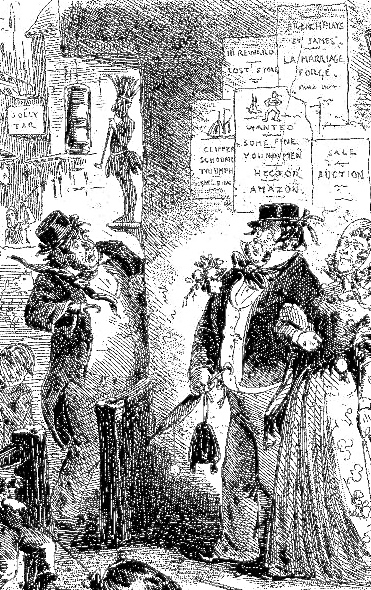Mrs. MacStinger and Bunsby
Sol Eytinge, Jr.
1867
Wood-engraving
10 x 7.4 cm (framed)
Dickens's Dombey and Son (Diamond Edition), facing III, 487.
[Click on image to enlarge it.]
Scanned image and text by Philip V. Allingham.
[Victorian Web Home —> Visual Arts —> Illustration—> Sol Eytinge, Jr. —> Dombey and Son —> Charles Dickens —> Next]
Mrs. MacStinger and Bunsby
Sol Eytinge, Jr.
1867
Wood-engraving
10 x 7.4 cm (framed)
Dickens's Dombey and Son (Diamond Edition), facing III, 487.
[Click on image to enlarge it.]
Scanned image and text by Philip V. Allingham.
[You may use these images without prior permission for any scholarly or educational purpose as long as you (1) credit the person who scanned the image, and (2) link your document to this URL in a web document or cite the Victorian Web in a print one.]
These peaceful scenes, and particularly the region of Limehouse Hole and thereabouts, were so influential in calming the Captain, that he walked on with restored tranquillity, and was, in fact, regaling himself, under his breath, with the ballad of Lovely Peg, when, on turning a corner, he was suddenly transfixed and rendered speechless by a triumphant procession that he beheld advancing towards him.
This awful demonstration was headed by that determined woman Mrs. MacStinger, who, preserving a countenance of inexorable resolution, and wearing conspicuously attached to her obdurate bosom a stupendous watch and appendages, which the Captain recognised at a glance as the property of Bunsby, conducted under her arm no other than that sagacious mariner; he, with the distraught and melancholy visage of a captive borne into a foreign land, meekly resigning himself to her will. Behind them appeared the young MacStingers, in a body, exulting. Behind them, two ladies of a terrible and steadfast aspect, leading between them a short gentleman in a tall hat, who likewise exulted. In the wake, appeared Bunsby’s boy, bearing umbrellas. The whole were in good marching order; and a dreadful smartness that pervaded the party would have sufficiently announced, if the intrepid countenances of the ladies had been wanting, that it was a procession of sacrifice, and that the victim was Bunsby.
The first impulse of the Captain was to run away. This also appeared to be the first impulse of Bunsby, hopeless as its execution must have proved. But a cry of recognition proceeding from the party, and Alexander MacStinger running up to the Captain with open arms, the Captain struck.
"Well, Cap’en Cuttle!" said Mrs. MacStinger. "This is indeed a meeting! I bear no malice now, Cap’en Cuttle — you needn’t fear that I’m a going to cast any reflections. I hope to go to the altar in another spirit." Here Mrs MacStinger paused, and drawing herself up, and inflating her bosom with a long breath, said, in allusion to the victim, "My ‘usband, Cap’en Cuttle!" [Ch 60, "Chiefly Matrimonial," 487]



Left: Phiz's introduction of the skipper of the "Cautious Clara":
Dickens, Charles. Dombey and Son. Illustrated by Hablot Knight Browne (Phiz). 8 coloured plates. London and Edinburgh: Caxton and Ballantyne, Hanson, 1910.
_______. Dombey and Son.16 Illustrations by Sol Eytinge, Jr., and A. V. S. Anthony (engraver). The Diamond Edition. Boston: Ticknor & Fields, 1867. III.
Hammerton, J. A.. "Ch. XVI. Dombey and Son." The Dickens Picture-Book. London: Educational Book Co., [1910], 294-338.
Last modified 12 December 2020
